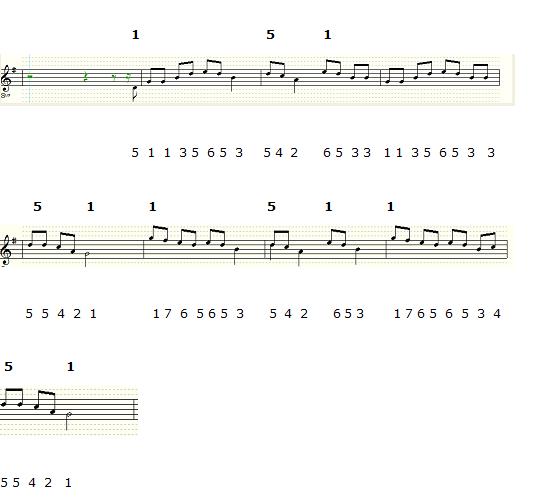Fiddlewidget for String Teachers
| Home | What's a Fiddlewidget? | Suppliers | Fiddlewidget University | Instruments |
Activity 3-The (Nashville) Number System;the Holy Grail of Improvisation
Time required: 35 minutes
Materials:
1.Printed copies of the chromatic scale notes with the major scale of the example
tune circled (G major in my example).
A Fiddlewidget for the instrument being used is very handy for this, because
the students can mark up that window with a dry-erase marker and just wipe it off when they're done.
Alternatively, just pencil and paper will work, and if you want the dry erase capability,
you can put clear tape over the part you wish to mark. Then it can be marked up again and again,
in different ways, with a dry-erase marker.
2. The chromatic-capable instrument that was used in the first part of
this activity.
Ask the students to circle the notes in the G major scale, if that has not already been done,
either with a regular pencil or with a dry-erase marker if you are using the clear tape. If you are using
Fiddlewidget tools, they just set it to "G" and the scale is automatically highlighted; everything not in
the G major scale is hidden.
Now have them mark right over the note names, or right beside them, by numbering them one through seven, ascending.
g=1, a=2, b=3, c=4, d=5, e=6, f#=7 Go ahead and put a "1" by the next higher g also, because that's
the number used for the root note in this system.
Now you can talk about the system.
Musicians of all styles have probably used it in some way, but I'm going to credit a 1950's group called the
Jordanaires, who started using numbers instead of note names to communicate for studio work.
By using these numbers instead of the note names, they could easily communicate their chord progressions in
any key, and make up numbered chord charts for songs that would work no matter what key they were played in.
I think they used Roman numerals instead of regular numbers, but for our purposes there is no reason to do this;
I just write down a 7 instead of VII, but you can do it either way. I find kids that don't know the Roman system
so I don't use it.
The numbers convey the notes' relative position within the scale (called the
"scale degree"), whereas the names of the notes don't do that. This is what gives this system it's usefulness
and power.
Let students take another look now at the G major scale, and based on the next bit of information
you are going to provide, write down the names of the notes in a G chord. There are two important points to get
across now:
1.The notes that make up a major chord are the first, third, and fifth notes of
that major scale.
These three notes are called a major triad. So if you lay out any major scale, then the major chord by that
name is the major triad, or the 1, 3, and 5 of that scale or key. This chord is "home plate" for any song in
that key; it almost always will start and end in that chord.
2.For almost all songs written in a major key, the primary chords are based upon the 1, the 4,
and the 5 notes of the scale. So for the key of G, the most common chords used will be the G major, C major
and D major chords. Some, like our example "Buffalo Gals", only need two chords, usually the 1 and the 5.
One other thing, now that we have introduced the concept of a major triad- it will be useful
to students if they can memorize the note names of the major triads. Eventually they will need to keep up with
the sharps and flats, but for now, knowing just the letter combinations will help as they work out chords on
the fly during jam sessions and such. These would be ACE, BDF, CEG, DFA, EGB, FAC, and GBD. If you can come up
with some kind of a memory hook to help recall those, you'd be surprised how much it can help. If you are going
to jam, arrange, transpose and play by ear you won't regret doing this.
Assessment:
1-Make sure everyone got the right notes for the G chord.
2- Look at the melody for Buffalo Gals below, where the melody notes are identified by their scale degrees.
Cover the written score staff notation, and using just the numbers, use the Fiddlewidget or some other method
to identify what those notes are in the key of G. Write the note names under the numbers, and check yourself now
by looking at the written score. Get 'em all? Now assume we are in a different key, like D or A, and convert
the numbers to the appropriate names in THAT key.
Available from nationally known music suppliers, or call Bruce Haney at (423) 349-6715 See how this works?
As a bonus question, can you come up with the correct names for the 1 and 5 chord triads in the key of G, D, and A?
This leads us to the next Activity, looking at the 4 and 5 chords in more depth.
See how this works?
As a bonus question, can you come up with the correct names for the 1 and 5 chord triads in the key of G, D, and A?
This leads us to the next Activity, looking at the 4 and 5 chords in more depth.
or
email at bfhaney@chartertn.net.